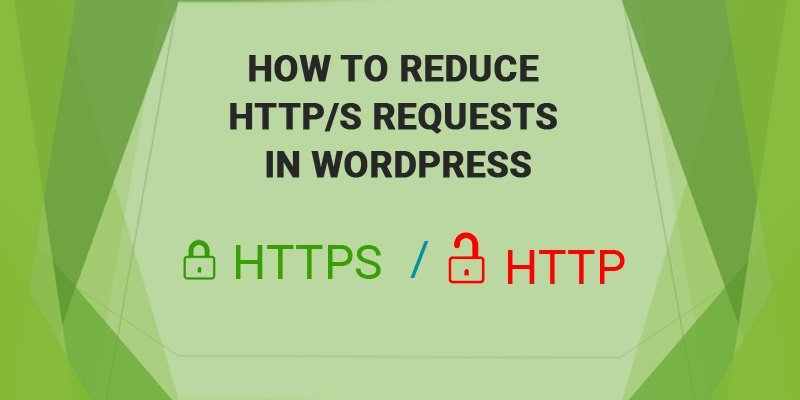How to Reduce HTTP/S Requests in WordPress

You wanted to reduce HTTP/S Requests on your WordPress website, In this article, you are going to learn how you can do that in your WordPress website. Before going into working on reducing the requests, let’s dig into what are HTTP/S requests and what are the tools you can use for checking the number of HTTP/S requests on any website.
What are HTTP/S requests?
Every time you load a website, the browser sends a request to the server. After the initial request, the server sends all the necessary files to load the complete website on a browser. These files include images, CSS files, js files audio and video files. Every file that is received by the browser is considered as a request.
The lower the number of requests on any website, higher the speed of a website. The website will load very quickly with few HTTP/S requests. And you already know website speed also one of the major ranking factors for search engines like google.
Later in this article, you will learn how to reduce the HTTP/S requests in WordPress.
Tools to Check the Number of HTTP/S Requests of a Website?
HTTP Requests Checker by feedthebot analyzes how many external HTTP requests your web page makes when it loads. Each request—for scripts, stylesheets, images, fonts, or other resources—can affect your site’s load speed and performance. The tool provides a detailed list of these requests, showing you what files are being fetched, their size, status codes, and source domains. This helps you identify unnecessary or slow-loading elements that could be optimized or removed.
Now you know what are the HTTP/S requests, if you know how to check the HTTP/S requests of a website then skip to the next step or else continue reading.
- Google Chrome Developer Tools / Firebug in Firefox
You can check the number of requests in Chrome browser with developer tools, you don’t have to install anything. If you are using Firefox then you should install the Firebug add-on, Firebug is also similar to Chrome Developer Tools.You can open the Chrome Developer Tools by going to More Tools > Developer Tools or use this shortcut Ctrl/Cmd+Shift+I.
Navigate to Network tab, Load the website you want to check the number of requests in the status bar you can see the number of HTTP/S requests of the website.
In Firefox, Just open the Firebug and click on the Net tab. Load the website, now you can see the number of requests in Firefox also.
- Pingdom Tools
Pingdom Tools is one of the best free tools available for website speed optimization and it’s easy to use. Just enter the domain name of the website, choose the Test Server Location and submit for testing. You will get the number of requests along with load time and a lot of useful information.Now you have the number HTTP/S requests from Pingdom Tools.
- GTmetrix
GTmetrix is also one of the best tools and it’s similar to Pingdom Tools, you will get a lot of information about website speed optimization in GTmetrix analysis.On the GTmetrix Analysis page, you can see the number of requests and the load time.
- Google PageSpeed Insights
With Google PageSpeed Insights you won’t get the number of HTTP/S requests. You can see the speed score by google. Just enter the domain name and click on analyze.In this analysis, you will see a lot of helpful tips to optimize website speed.
How to Reduce HTTP/S Requests in WordPress
In this step, you will learn tips to reduce HTTP/S Requests for any website, especially in WordPress. For reducing the requests, we should reduce the number of files loading for a website. If you’re not very familiar with basic web development tools, here’s some coding for beginners stuff to get you started.
Now, we can reduce these number of files by following these simple steps.
- Delete Unnecessary Files/Images
If you are loading any unnecessary images or files on your website, just remove them from your website’s source code. By just following this tip, you can reduce a lot of requests.If you are using a lot of images for loading icons and other UI design elements, that means you are creating a lot of requests for small images. You can reduce these requests by creating CSS Image Sprite in the next step.
- Reduce File Size
This technique is not for reducing the number of HTTP/S requests, but it helps to reduce the size of the overall webpage and improves the speed of the page. We can reduce the file size of images by compressing the images. And we can reduce the size of CSS & JS files by minifying and combine all the files into a single file.For compressing images without any loss you can use these WordPress plugins.
WP Smush plugin
Imagify - Create a CSS Image Sprite
If you are using image icons and other UI design elements, create an Image Sprite and load the icons using CSS positioning. Or you can migrate to the icon library/toolkit like Font Awesome. - Combine, Minify CSS and JavaScript Files
To reduce the number of HTTP/s requests, you should Combine all the CSS and JavaScript files. In WordPress websites, with every plugin you install, There will be CSS & JS files associated with it. The best way to combine and minify these files is with a caching plugin. You will learn about caching plugins in the last step. - Limit External Images/Files/Assets
Based on your website’s number of HTTP/S requests from the second step, if there are too many external resources like Images/Files/Assets. Try to remove the external resources that are not required.You can download these external resources on to your own server and load it from your own server. Or else you can use CDN service like MaxCDN.
- Use Caching Plugin
In WordPress, you can achieve all the above with plugins. Just activate the plugin and enable the checkboxes to use the features.These are the two popular in WordPress, they are WP Super Cache and W3 Total Cache.
With these plugins, you can enable the page caching. So everytime web page is requested, this request won’t be sent to the database. This web page is loaded from a static HTML cached page. You can purge the cache from the WordPress admin toolbar.
You can Combine, Minify CSS and JavaScript Files from these plugins by just enabling the feature. One more speed improvement tip is you can move the minified JS file to before closing body section instead of head section.
From the W3 Total Cache plugin, you can integrate it with CDN services like MaxCDN.
Using a caching plugin in WordPress is the easiest way to reduce the number HTTP/S requests.
Conclusion
Reducing the number of HTTP/S requests on your website can make your website load faster. Your websites search engine ranking positions will be improved. So you can get more traffic and more conversions, result in more revenue.
By just taking a few simple steps to reduce HTTP/S requests on your WordPress website you can reap the benefits in the long run for your business.

